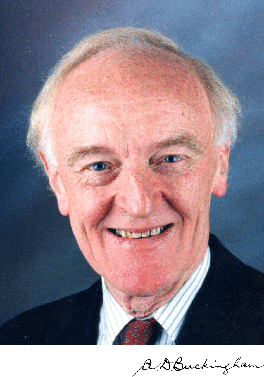A. David Buckingham facts for kids
Quick facts for kids
A. David Buckingham
CBE, FRS
|
|
|---|---|
 |
|
| Born | 28 January 1930 Sydney, Australia
|
| Died | 4 February 2021 (aged 91) Cambridge, England
|
| Alma mater | Cambridge University |
| Known for | Theory of electric, magnetic and optical properties of molecules Theory of intermolecular forces |
| Spouse(s) | Jillian Bowles |
| Children | 3 |
| Awards | Ahmed Zewail Prize in Molecular Sciences (2006) |
| Scientific career | |
| Fields | Theoretical chemistry Chemical physics |
| Institutions | Oxford University University of Bristol Cambridge University |
| Doctoral advisor | John Pople |
| Notable students | Laurence D. Barron Brian Orr |
Amyand David Buckingham (born January 28, 1930 – died February 4, 2021) was a brilliant Australian scientist. He was born in Pymble, a suburb of Sydney, Australia. He was an expert in chemical physics, which combines ideas from chemistry and physics to understand how molecules work.
Life and Career
David Buckingham started his studies at the University of Sydney. There, he earned his first science degrees. Later, he went to the University of Cambridge in England. He completed his PhD under the guidance of a famous scientist, John Pople.
He worked at Oxford University from 1955 to 1965. He was a lecturer and a fellow at Christ Church, Oxford. After that, he became a Professor of Theoretical Chemistry at the University of Bristol. In 1969, he moved back to Cambridge University. He became a Professor of Chemistry there.
Many important groups recognized his amazing work. He was chosen as a Fellow of the Royal Society in 1975. This is a very high honor for scientists in the United Kingdom. He also became a Fellow of the American Physical Society. In 1992, he joined the U.S. National Academy of Sciences as a Foreign Associate. He was also a member of the International Academy of Quantum Molecular Science. In 2008, he was elected to the Australian Academy of Science.
Professor Buckingham received several awards for his discoveries. In 2006, he won the first Ahmed Zewail Prize in Molecular Sciences. This award celebrates big contributions to understanding molecules. He also won the Harrie Massey Medal and Prize in 1995.
Beyond science, Professor Buckingham loved cricket! He played 10 first-class matches. These were for Cambridge University and Free Foresters. He even served as the President of the Cambridge University Cricket Club for many years.
He finished his career as an Emeritus Professor of Chemistry at Cambridge University. He was also an Emeritus Fellow at Pembroke College, Cambridge.
Scientific Contributions
Professor Buckingham's research focused on understanding molecules. He studied their electric, magnetic, and optical properties. He also explored how molecules interact with each other. These interactions are called intermolecular forces.
Early in his career, he studied how liquids behave electrically. He looked at things like dipole moments of molecules. These are like tiny magnets within molecules. He developed theories about how molecules in liquids and gases react to electric and magnetic fields. In 1959, he suggested a way to measure a molecule's quadrupole moment. This is another way to describe how electric charge is spread out in a molecule. He proved this idea in 1963 using the carbon dioxide molecule.
He also studied how solvents affect nuclear magnetic resonance (NMR) spectra. NMR helps scientists learn about the structure of molecules. In 1971, he and Laurence Barron started studying Raman optical activity. This method uses light to understand the shape of molecules. It's especially useful for chiral molecules. These are molecules that are mirror images of each other, like your left and right hands.
In the 1980s, he showed how important long-range intermolecular forces are. These forces help determine the structure of small groups of molecules. This work was also useful for understanding large molecules found in living things. In 1990, he predicted how an electric field affects light reflecting off surfaces. In 1995, he proved an important rule about how chiral molecules absorb light.
Personal Life
In 1964, David Buckingham met Jillian Bowles on a ship. She was a physiotherapist. They got engaged in 1965 and married soon after. They were married for over 55 years. They had three children: Lucy, Mark, and Alice. They also had eight grandchildren.
Amyand David Buckingham passed away in Cambridge on February 4, 2021. He was 91 years old. He is remembered by his wife, children, and grandchildren.
See also
- Buckingham (unit)

